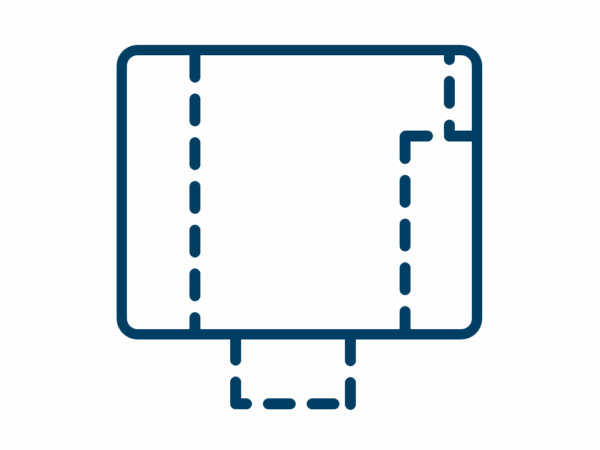Complex space is not a vanilla unit / listing / pocket. It’s a combination of different types of space that can’t be separately leased.
High level example: an industrial building made up of office, warehouse, workshop and storage. You can’t take the warehouse, but leave the others.
The vanilla case in CRE is when one unit / listing / pocket is made up of one type of space. For example an industrial unit of 5,000 sqm, or an office unit of 1,000 sqm, or a retail unit of 250 sqm. Complex space is not the vanilla case.
Two criteria for a complex space:
- One unit / listing / pocket is made up of two or more types of space. And, critically,
- Renting such complex space is an “all or nothing” arrangement – you either have to lease all of the space, or none of it**. You can’t “cherry-pick” certain sub-spaces (because the “orphaned” sub-spaces are tricky to lease separately).
** For example, it would be very difficult for a landlord to find a tenant for a 500 sqm unlet office pocket in a 10,000 sqm factory located deep in a heavy industrial area. Similarly, using a property example, it is unlikely that a tenant will be comfortable with the risk of another, arms-length business leasing an unused 60 sqm of storage space inside of its leased premises (and having that arms-length business’s staff trooping in and out of its offices on a daily basis).
Examples of complex space per primary property category
- Industrial: A 5,000 sqm warehouse unit is made up of 3,500 sqm of warehouse, 1,000 sqm of office, 300 sqm of workshop and 200 sqm of storage/store room
- Office: A 1,000 sqm office unit is made up 800 sqm of office, 150 sqm of terrace, and 50 sqm of storage/store room
- Retail: A 250 sqm retail unit is made of 180 sqm retail, 40 sqm of storage/store room and 30 sqm of office
Layer one of complexity (complex space)
Those sub-spaces may be priced at different rentals.
For example – the total industrial complex space of 5,000 sqm (for a total asking rental of R393,500) is priced as follows
- Warehouse | 3,500 sqm | R65 / sqm
- Office | 1,000 sqm | R140 / sqm
- Workshop | 300 sqm | R60 / sqm
- Storage / store room | 200 sqm | R40 / sqm
Weighted average rental value: R78.70 / sqm
If you multiply the weighted average rental of R78.70 / sqm by the total 5,000 sqm space, you will get to the (correct) total asking rental of R393,500.
Calculation of weighted average #1: (warehouse of 3,500 sqm / 5,000 sqm total x R65 ) + (office of 1,000 sqm / 5,000 sqm total x R140 ) + (workshop of 300 sqm / 5,000 sqm total x R60) + (storage of 200 sqm / 5,000 sqm total x R40) = R 78.70 / sqm
Calculation of weighted average #2: total rental / total space = R78.70 / sqm
Calculation of weighted average rental #3: [ (warehouse of 3,500 sqm x R65 ) + (office of 1,000 sqm R140 ) + (workshop of 300 sqm x R60) + (storage of 200 sqm x R40) ] / 5,000 sqm = R 78.70 / sqm
Note: for purposes of calculation, the average rental value: R 76.25 / sqm is misleading
Calculation of average: (R 65 + R140 + R60 + R40) / 4 sub-spaces = R76.25 / sqm
If you multiply the average rental value by the total space, you will get to R381,250, which is wrong.
For more information on weighted average rentals, please see this post
Layer two of complexity (complex space)
Not all space is created equal… Some space satisfies the criteria of usable area, other space as GLA, other space is “rent-attracting supplementary space“, other space is “not rent-attracting supplementary space“.
So, depending on what you are asked (i.e. what is the total space, or the total usable space or the total GLA), to be technically correct, you may have to provide different numbers.
For example – the total office complex space of 1,000 sqm is made up as follows
- Office | 800 sqm | GLA
- Terrace | 150 sqm | Rent-attracting supplementary space
- Storage / store room | 50 sqm | GLA
- Balcony | 80 sqm | Not rent-attracting supplementary space
Total space 1,080 sqm, of which
- 850 sqm is GLA (note your usable area will only ever be less than or equal to this),
- 150 sqm is rent-attracting supplementary space, and
- 80 sqm is not rent-attracting supplementary space
One final point, your floor plate may differ to total space. For example, you have an industrial property that has a roof (floorplate) of say 8,000 sqm. 7,000 of that may be industrial at say 9 meters to the eaves, serviced by three stories of office. Each story of office may be 1,000 sqm. 3 stories x 1,000 sqm = 3,000 sqm office. Total rentable area of that complex space: 3,000 sqm office + 7,000 sqm of industrial.
Layer three of complexity (complex space)
Here we are looking at how rental-related expenses are allocated.
Again, everything in CRE is up for negotiation, but the general rule is that expenses included in gross rental (expressed as R / sqm) are only allocated to space defined as GLA. (I.e. expenses are not allocated to supplementary space – rent-attracting and not rent-attracting)








